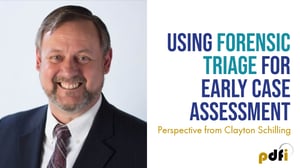 When you're faced with a mountain of digital evidence, how do you start sifting through it? For law enforcement, litigation support, and incident response agencies organizing and prioritizing digital media and electronically stored information (ESI) is crucial.
When you're faced with a mountain of digital evidence, how do you start sifting through it? For law enforcement, litigation support, and incident response agencies organizing and prioritizing digital media and electronically stored information (ESI) is crucial.
Adopting an Early Case Assessment (ECA) methodology helps expedite and improve overall case efficiency and productivity; reducing backlogs and increasing turnaround times.
Components of Early Case Assessment
One of the goals of Early Case Assessment is to determine whether identified digital media or ESI has evidentiary value. This is accomplished by gathering as much knowledge about the digital evidence as possible. Investigators and legal teams work to:
-
Assess the likelihood that a particular item of digital media contains useful information
-
Narrow down datasets using keywords
-
Retrieve immediate need relevant evidence and information
By identifying relevant digital media and organizing and paring down ESI into manageable blocks, investigators and legal teams can more easily assess the needs, risks and costs of pursuing further investigation or litigation. Being able to quickly sort and view evidence is vital in determining which items are most pertinent to a case.
Early Case Assessment Tools
The reality today is there is just simply too much data to collect, process and analyze so; it is vital that investigators and legal teams focus on relevant digital media and ESI only. Currently, law enforcement agencies are facing an ever-growing digital forensic backlog and unless existing methodologies change, there is no end in sight. Fortunately, forensic triage provides a valuable solution to solving this problem. Products like ADF's Triage-Investigator allow forensic examiners to set the foundations of an ECA right from the beginning. By prioritizing devices and ESI that are most likely to contain meaningful evidence, you can avoid getting bogged down in fruitless examinations, and consequently, reduce your collection intake and production backlogs.
ADF products quickly and reliably analyze numerous types of evidence, including documents, USB and Internet histories, cloud storage data, saved system credentials, and cryptocurrency information. Once collected, you can organize and search within a single timeline. Not only do digital forensic triage tools help investigators find evidence quickly, but they also assist with organization and reporting. Clear, organized evidence can be shared with legal teams so that cases can be solved promptly.
Start solving cases quickly and reducing your backlog with Triage-Investigator.


